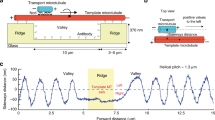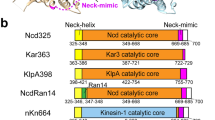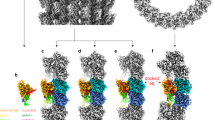Abstract
Kinesin-1 is a nanoscale molecular motor that walks towards the fast-growing (plus) ends of microtubules, hauling molecular cargo to specific reaction sites in cells. Kinesin-driven transport is central to the self-organization of eukaryotic cells and shows great promise as a tool for nano-engineering1. Recent work hints that kinesin may also play a role in modulating the stability of its microtubule track, both in vitro2,3 and in vivo4, but the results are conflicting5,6,7 and the mechanisms are unclear. Here, we report a new dimension to the kinesin–microtubule interaction, whereby strong-binding state (adenosine triphosphate (ATP)-bound and apo) kinesin-1 motor domains inhibit the shrinkage of guanosine diphosphate (GDP) microtubules by up to two orders of magnitude and expand their lattice spacing by ~1.6%. Our data reveal an unexpected mechanism by which the mechanochemical cycles of kinesin and tubulin interlock, and so allow motile kinesins to influence the structure, stability and mechanics of their microtubule track.
This is a preview of subscription content, access via your institution
Access options
Access Nature and 54 other Nature Portfolio journals
Get Nature+, our best-value online-access subscription
$29.99 / 30 days
cancel any time
Subscribe to this journal
Receive 12 print issues and online access
$259.00 per year
only $21.58 per issue
Buy this article
- Purchase on Springer Link
- Instant access to full article PDF
Prices may be subject to local taxes which are calculated during checkout





Similar content being viewed by others

References
Bachand, G. D., Spoerke, E. D. & Stevens, M. J. Microtubule-based nanomaterials: Exploiting nature’s dynamic biopolymers. Biotechnol. Bioeng. 112, 1065–1073 (2015).
Katsuki, M., Drummond, D. R. & Cross, R. A. Ectopic A-lattice seams destabilize microtubules. Nat. Commun. 5, 3094 (2014).
Lombillo, V. A., Stewart, R. J. & McIntosh, J. R. Minus-end-directed motion of kinesin-coated microspheres driven by microtubule depolymerization. Nature 373, 161–164 (1995).
Marceiller, J., Drechou, A., Durand, G., Perez, F. & Poüs, C. Kinesin is involved in protecting nascent microtubules from disassembly after recovery from nocodazole treatment. Exp. Cell. Res. 304, 483–492 (2005).
Kowalski, R. J. & Williams, R. C. Unambiguous classification of microtubule-ends in vitro: dynamic properties of the plus- and minus-ends. Cell. Motil. Cytoskelet. 26, 282–290 (1993).
Daire, V. et al. Kinesin-1 regulates microtubule dynamics via a c-Jun N-terminal kinase-dependent mechanism. J. Biol. Chem. 284, 31992–32001 (2009).
Fukata, K. A., Watanabe, H., Iwamatsu, A. & Kaibuchi, K. Tubulin and CRMP-2 complex is transported via kinesin-1. J. Neurochem. 93, 1371–1382 (2005).
Nakata, T. & Hirokawa, N. Point mutation of adenosine triphosphate-binding motif generated rigor kinesin that selectively blocks anterograde lysosome membrane transport. J. Cell. Biol. 131, 1039–1053 (1995).
Cross, R. A. The kinetic mechanism of kinesin. Trends Biochem. Sci. 29, 301–309 (2004).
VanDelinder, V., Adams, P. G. & Bachand, G. D. Mechanical splitting of microtubules into protofilament bundles by surface-bound kinesin-1. Sci. Rep. 6, 39408 (2016).
Kabir, A. M. R. et al. Biomolecular motor modulates mechanical property of microtubule. Biomacromolecules 15, 1797–1805 (2014).
Krebs, A., Goldie, K. N. & Hoenger, A. Complex formation with kinesin motor domains affects the structure of microtubules. J. Mol. Biol. 335, 139–153 (2004).
Morikawa, M. et al. X-ray and cryo-EM structures reveal mutual conformational changes of kinesin and GTP-state microtubules upon binding. EMBO J. 34, 1270–1286 (2015).
Alushin, G. M. et al. High-resolution microtubule structures reveal the structural transitions in αβ-tubulin upon GTP hydrolysis. Cell 157, 1117–1129 (2014).
Nakata, T., Niwa, S., Okada, Y., Perez, F. & Hirokawa, N. Preferential binding of a kinesin-1 motor to GTP-tubulin-rich microtubules underlies polarized vesicle transport. J. Cell. Biol. 194, 245–255 (2011).
Zhang, R., Alushin, G. M., Brown, A. & Nogales, E. Mechanistic origin of microtubule dynamic instability and its modulation by EB proteins. Cell 162, 1–11 (2015).
Muto, E. E., Sakai, H. H. & Kaseda, K. K. Long-range cooperative binding of kinesin to a microtubule in the presence of ATP. J. Cell. Biol. 168, 691–696 (2005).
Arora, K. et al. KIF14 binds tightly to microtubules and adopts a rigor-like conformation. J. Mol. Biol. 426, 2997–3015 (2014).
Chen, Y. & Hancock, W. O. Kinesin-5 is a microtubule polymerase. Nat. Commun. 6, 8160 (2015).
Hibbel, A. et al. Kinesin Kip2 enhances microtubule growth in vitro through length-dependent feedback on polymerization and catastrophe. eLife 4, e10542 (2015).
Alonso, M. C. et al. An ATP gate controls tubulin binding by the tethered head of kinesin-1. Science 316, 120–123 (2007).
Sirajuddin, M., Rice, L. M. & Vale, R. D. Regulation of microtubule motors by tubulin isotypes and post-translational modifications. Nat. Cell. Biol. 16, 335–344 (2014).
Vale, R. D., Coppin, C. M., Malik, F., Kull, F. J. & Milligan, R. A. Tubulin GTP hydrolysis influences the structure, mechanical properties, and kinesin-driven transport of microtubules. J. Biol. Chem. 269, 23769–23775 (1994).
Carter, N. J. & Cross, R. A. Mechanics of the kinesin step. Nature 435, 308–312 (2005).
Cross, R. A. & McAinsh, A. Prime movers: the mechanochemistry of mitotic kinesins. Nat. Rev. Mol. Cell. Biol. 15, 257–271 (2014).
Hendricks, A. G. et al. Dynein tethers and stabilizes dynamic microtubule plus ends. Curr. Biol. 22, 632–637 (2012).
Blehm, B. H., Schroer, T. A., Trybus, K. M., Chemla, Y. R. & Selvin, P. R. In vivo optical trapping indicates kinesin’s stall force is reduced by dynein during intracellular transport. Proc. Natl Acad. Sci. USA 110, 3381–3386 (2013).
Perur, N., Yahara, M., Kamei, T. & Tamaoki, N. A non-nucleoside triphosphate for powering kinesin–microtubule motility with photo-tunable velocity. Chem. Commun. 49, 9935–9937 (2013).
Crevel, I. et al. What kinesin does at roadblocks: the coordination mechanism for molecular walking. EMBO J. 23, 23–32 (2004).
Smith, M. B. et al. Segmentation and tracking of cytoskeletal filaments using open active contours. Cytoskeleton 67, 693–705 (2010).
Acknowledgements
The authors thank D. R. Drummond and N. Sheppard for assistance with protein purification, and T. A. McHugh for commenting on the manuscript. This research was funded by the Biotechnology and Biological Sciences Research Council (grant number BB-G530233–1) via the Systems Biology Doctoral Training Centre, University of Warwick; and the Wellcome Trust (grant number 103895/Z/14/Z).
Author information
Authors and Affiliations
Contributions
D.R.P. and R.A.C. designed the experiments. N.J.B. provided mathematical insight. D.R.P. designed the analyses, collected and analysed the data, developed the microfluidics interface and produced the manuscript and figures. All the authors contributed towards the discussion and interpretation of results, and editing the manuscript.
Corresponding author
Ethics declarations
Competing interests
The authors declare no competing interests.
Additional information
Publisher’s note: Springer Nature remains neutral with regard to jurisdictional claims in published maps and institutional affiliations.
Supplementary information
Supplementary Information
Supplementary Figures 1–5, Supplementary Tables 1–2, Supplementary methods, Supplementary references.
Supplementary Movie 1 | A kinesin surface-clamp assay
The image data (top) corresponds to the kymograph in Fig. 2c (bottom). A minus-end trail is clearly seen in the no-nucleotide phase. Addition of ADP causes the microtubule tips to shrink. In this case, the minus-end trail is retained during shrinkage. Microtubules are re-stabilized upon addition of taxol and ATP, and the resulting kinesin-driven microtubule gliding reveals the microtubule polarity.
Supplementary Movie 2 | Strong-binding state kinesin can lock the curvature of GDP-microtubules.
For each concentration of T93N, images are sorted according to the microtubule orientation. The marked microtubules in each row (orange asterisks) fall into the orientation range depicted by the protractor diagrams (left). Microtubules are straight and dynamically unstable at the beginning of the movie. Arrows (top) highlight the presence and direction of hydrodynamic flow, which causes microtubule bending. In the absence of kinesin, stopping the flow causes the microtubules to re-straighten and continue to depolymerize. Microtubule curvature is preserved at low concentrations of T93N but not at high concentrations. Microtubules also transiently crinkle when T93N is flowed through at high concentrations.
Supplementary Movie 3 | Kinesin reversibly expands microtubules under constant hydrodynamic flow
The movie corresponds to the microtubule shown in Fig. 5b. As kinesin and ADP are alternately introduced into the flow, the microtubule visibly expands and contracts, most obviously seen by the downstream microtubule tip visibly shifting right and left. Both surface-free and transient surface-snagging behaviour can be seen in this movie, and the microtubule expands to the same extent in each case (Fig. 5d).
Supplementary Movie 4 | Microtubules briefly crinkle when kinesin is introduced to the flow
An ADP-to-kinesin transition is shown, during which the microtubule crinkles and thereby dips in and out of the TIRF illumination. Most of the microtubules are visibly free from the surface for the duration.
Supplementary Movie 5 | Kinesin increases the lattice spacing of surface-stitched GDP-microtubules
The movie corresponds to the microtubule shown in Fig. 5g. Part way through the movie, 200 nM of monomeric kinesin (K340) was flowed through the channel and the microtubule extends and bows so as to follow a longer path length. Flushing with 1 mM ADP triggers kinesin unbinding, and the microtubule reverts to its original length. After washing the sample thoroughly with buffer, the process can be repeated. After the first cycle, the microtubule becomes tethered to the surface at a greater number of interaction sites. During the second kinesin flow-through, part of the microtubule briefly goes out of focus but it is recruited back into the optical plane, demonstrating that our protocol restricts motion in the z-axis to permit reliable quantification. Arrows indicate when the solution is flowing. Scale bar, 10 µm.
Supplementary Animation 1 | Kymograph profile matching for measuring microtubule expansion
The ‘original’ kymograph shown is the same as in Fig. 5b. The ‘transformed’ kymograph is the same image but each row has been compressed by the values shown in Fig. 5d. This highlights the uniform expansion of the microtubule that occurs when kinesin binds.
Rights and permissions
About this article
Cite this article
Peet, D.R., Burroughs, N.J. & Cross, R.A. Kinesin expands and stabilizes the GDP-microtubule lattice. Nature Nanotech 13, 386–391 (2018). https://doi.org/10.1038/s41565-018-0084-4
Received:
Accepted:
Published:
Issue Date:
DOI: https://doi.org/10.1038/s41565-018-0084-4
This article is cited by
-
Taxol acts differently on different tubulin isotypes
Communications Biology (2023)
-
A human proteogenomic-cellular framework identifies KIF5A as a modulator of astrocyte process integrity with relevance to ALS
Communications Biology (2023)
-
Mechanisms of microtubule organization in differentiated animal cells
Nature Reviews Molecular Cell Biology (2022)
-
Microtubule lattice spacing governs cohesive envelope formation of tau family proteins
Nature Chemical Biology (2022)
-
Dexamethasone accelerates muscle regeneration by modulating kinesin-1-mediated focal adhesion signals
Cell Death Discovery (2021)


